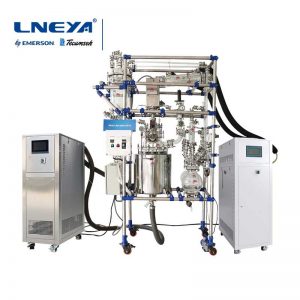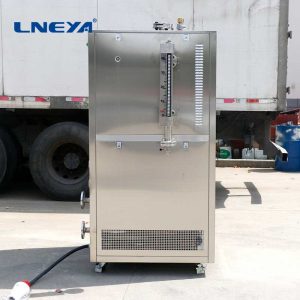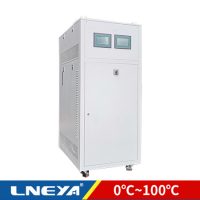Heater Chiller
Heater chiller is also called high and low temperature all-in-one machine, refrigeration heating temperature control system, etc. in the industry. Different manufacturers may call it differently, but the functions of this type of equipment are similar. They are routinely used in supporting reaction kettles in the pharmaceutical and chemical industries. To provide the temperature requirements for heat absorption and heat release.
First, the application introduction of heater chiller
1. The heater chiller can be equipped with reactors, reactors, extraction equipment, rotary evaporators and other instruments to increase and decrease different temperatures, and provide endothermic and exothermic reactions. Users can use explosion-proof reactors to achieve their needs. The temperature range supported by our equipment is -120°C~350°C.
2. The heater chiller can provide accurate temperature process control. It can be equipped with one reactor or multiple reactors for cooling, heating and temperature control. Using a closed circulation pipeline system, water vapor will not be absorbed during low-temperature reactions, and high-temperature reactions will not Oil mist will be generated, which can realize connection temperature rise and fall control within a certain range.
Second, precautions for heater chiller
1. Read the instruction manual before using the heater chiller, and have a certain understanding of the appearance and configuration of the equipment;
2. Turn on the power of the heater chiller, and set it according to the circuit requirements in the manual;
3. The switch of the heater chiller can be set separately and connected in parallel in the circuit to ensure that the shutdown of other equipment circuit failures will not affect the use of the equipment;
4. Check the tightness of the connecting pipeline interface between the heater chiller and supporting equipment;
5. When the heater chiller is connected to supporting equipment, care should be taken to avoid air bubbles remaining in the system, to ensure that the outlet of the heat transfer medium is connected to the lower interface of the reactor, and the inlet of the heat transfer medium is connected to the upper interface of the reactor;
6. When filling the heat transfer oil, you need to pay attention to the type of heat transfer oil. Different models have different temperature requirements. The temperature range of the heater chiller should match the temperature range of the heat transfer oil;
7. When the heater chiller is filled with heat-conducting medium, care should be taken to prevent the heat-conducting medium from overflowing to the upper cover plate, and the liquid overflowing to the upper cover plate may cause the heat-conducting medium to leak into the electrical components of the equipment, which may cause equipment failure;
8. When the temperature control effect of the equipment is not satisfactory, the user can perform system self-tuning. During the self-tuning process, the temperature will have a large overshoot, and the user should fully consider this factor before performing the system self-tuning;
9. After the heater chiller is filled with heat transfer medium and exhausted, it can start to control the temperature. After setting the temperature, press the circulation button and the refrigeration button (the circulation pump must be kept working when the equipment is running, otherwise it will cause system error). When the temperature reaches the set value, the refrigeration will be automatically turned off, and the refrigeration compressor will be turned on after the temperature rises;
Heater chiller is a kind of equipment that integrates heating, high temperature and cooling technology of cooling, heating and temperature control. During use, you need to use and maintain your product correctly, so that the equipment can be kept in good operating condition and exert high-quality temperature control effect.
Soluciones personalizadas para su empresa
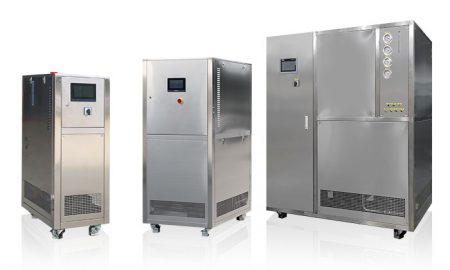
Sistemas de refrigeración y calefacción (serie SUNDI)
Rango de control de temperatura: -120°C a +350°C
Application: Various Reactors (Microchannels, Glass, Jacketed Reactors, etc.), Distillation or Extraction System, Laboratory, University, Research Institute, Aerospace, Automotive Industry, Semiconductor and Electrical Test, Chemical, Pharmaceutical, Petrochemical, Biochemical, Medical, Hospital, R&D Workshop, Aerospace, Biological and Other Industries.
| Temperatura | Serie -40 ~ +200°C | Serie -10 ~ +200°C | Serie -25 ~ +200°C | Serie -25 ~ +300°C | Serie -45 ~ +250°C | Serie -45 ~ +300°C | Serie -60 ~ +250°C | Serie -60 ~ +300°C | Serie -70 ~ +250°C | Serie -80 ~ +250°C | Serie -90 ~ +250°C | Serie -100 ~ +100°C | -25 ~ +200°C una máquina para dos reactores | -40 ~ +200°C una máquina para dos reactores |
| Capacidad de refrigeración | hasta 3 kW | hasta 15 kW | hasta 200 kW | hasta 200 kW | hasta 200 kW | hasta 25 kW | hasta 60 kW | hasta 25 kW | hasta 15 kW | hasta 80 kW | hasta 80 kW | hasta 80 kW | hasta 10*2 kW | hasta 10*2 kW |
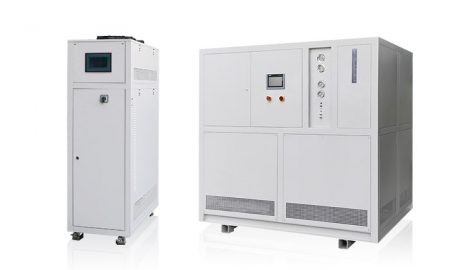
Sistemas de refrigeración y calefacción (serie WTD)
(Microcanales / reactores tubulares especializados)
Rango de control de temperatura: de -70°C a +300°C
Diseño especializado para microcanal (pequeña capacidad de retención de líquido, gran capacidad de intercambio de calor, sistema de circulación de alta caída de presión)
| Temperatura | -70°C ~ +300°C | -45°C ~ +250°C | -70°C ~ +200°C |
| Capacidad de refrigeración | up to 7.5kW | up to 5.5kW | hasta 50 kW |
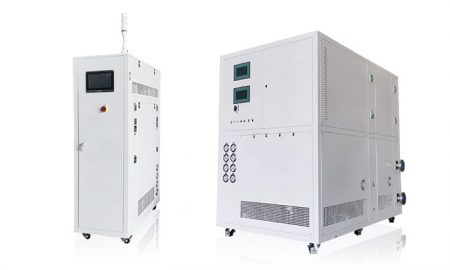
Cooling and Heating Systems (TES series)
Temperature Control Range: -85°C ~ +250°C
Temp Control Accuracy: ± 0.3°C
| Temperatura | Serie -45°C ~ +250°C | Serie -85°C ~ +200°C | Serie -60°C ~ +200°C |
| Capacidad de refrigeración | hasta 25 kW | hasta 25 kW | hasta 60 kW |
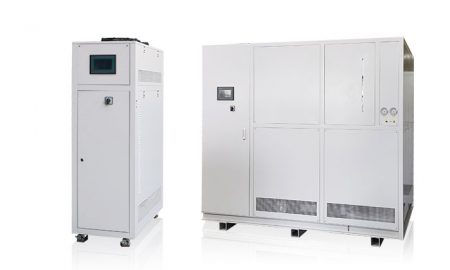
Cooling and Heating Machines (LTS series)
Temperature Control Range: -80°C to +80°C
It is widely used in the semiconductor process to control the temperature of the reaction chamber, the hot sink plate and the non-flammable heat transfer medium.
| Temperatura | Serie -20°C ~ +80°C | Serie -45°C ~ +80°C | Serie -60°C ~ +80°C | Serie -80°C ~ +80°C |
| Control de caudal | 7 ~ 45 L/min | 7 ~ 45 L/min | 7 ~ 45 L/min | 7 ~ 45 L/min |
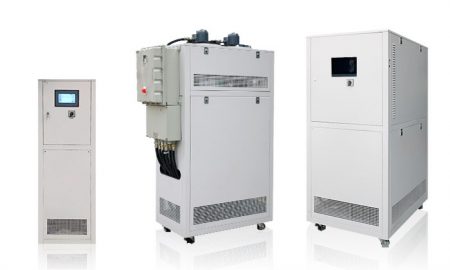
Circuladores de refrigeración y calefacción
Rango de control de temperatura: -45°C a +250°C
Application: Various Reactors (Microchannels, Glass, Jacketed Reactors, etc.), Distillation or Extraction System, Laboratory, University, Research Institute, Aerospace, Chemical, Pharmaceutical, Petrochemical, Biochemical, Medical, Hospital, R&D Workshop, Aerospace, Biological and Other Industries.
| Temperatura | Serie -25°C ~ +200°C | Serie -45°C ~ +250°C |
| Capacidad de refrigeración | hasta 15 kW | hasta 15 kW |
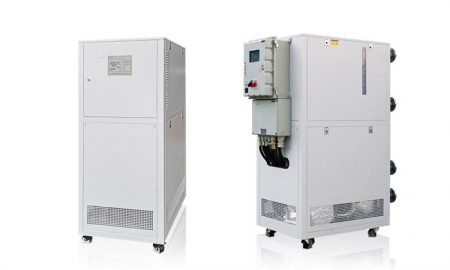
Termostatos de circulación
Rango de control de temperatura: +50°C a +300°C
Nota: La serie UC puede controlar la temperatura del medio de transferencia de calor. La serie UST no solo puede controlar la temperatura del medio de transferencia de calor, sino también la temperatura del material de reacción.
| Temperatura | +50°C ~ +200°C (UC series) | +50°C ~ +300°C (serie UC) | +50°C ~ +300°C (serie UST) |
| Capacidad de calefacción | hasta 38 kW | hasta 200 kW | hasta 95 kW |
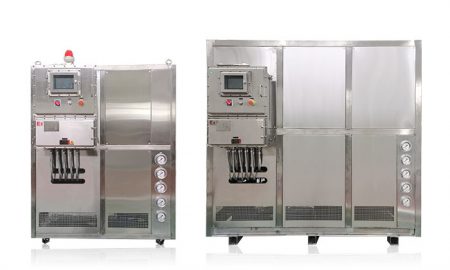
TCU Sistema de control de temperatura multirreactores
Rango de control de temperatura: -120°C a +250°C
Application: Various Reactors (Microchannels, Glass, Jacketed Reactors, etc.), Distillation or Extraction System, Laboratory, University, Research Institute, Aerospace, Chemical, Pharmaceutical, Petrochemical, Biochemical, Medical, Hospital, R&D Workshop, Aerospace, Biological and Other Industries.
| Temperatura | Serie -45°C ~ +250°C | Serie -120°C ~ +250°C | Sistema de control de temperatura personalizado | RT+10°C ~ +135°C |
| Capacidad de calefacción | hasta 80 kW | hasta 80 kW | A medida | up to 300kW |
 LNEYA
LNEYA
 简体中文
简体中文












































































